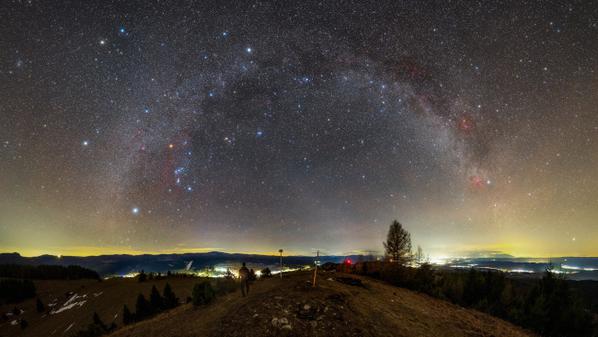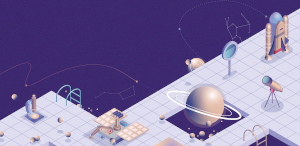This page describes an image Warm Winter Night Over Spiš Region
Image caption:
Winner in the 2022 IAU OAE Astrophotography Contest, category Still images of celestial patterns.
This image, taken in Slovakia in January 2022, shows regions of the Milky Way and a rich variety of constellations. The summer constellations of the northern hemisphere are very low in the sky towards the bottom-right. The bright stars of Cygnus and Lyra shine through the artificial lights at the horizon. The huge array of northern winter and autumn constellations with many bright stars are associated with diverse cultural stories.
For the Lakota people in North America the belt of the Orion constellation represents the spine of a bison (“Tayamnicankh”). Orion, the Hunter of Greek mythology, is sometimes described chasing the Seven Sisters, the Pleiades. The Arabs transformed this view by considering the follower of the Pleiades only one star instead of a constellation. Aldebaran, the star in the right eye of Taurus, the Bull, comes from this interpretation, because the name Aldebaran derives from al-dabaran, The Follower.
At the bottom-right, on the horizon, we can see the milky lightcone of the Zodiacal light stretching from the constellation Pisces through Aries, almost reaching the Pleiades, indicating the path of the planets and the Moon in this area. The Pleiades and the Hyades together form a gate on this path, where the heavenly bodies occasionally pass before entering the Milky Way. The planets were considered sheep in ancient Babylon and the modern constellation Orion was considered the “True Shepherd” of the Sky, with his shepherd’s tool reaching the ecliptic. In Roman tradition, the bright white star above the Pleiades and the Milky Way is called Capella, the Goat, which can be traced back to an Egyptian constellation in this area.
Above the treetop in the middle-right part of the image, we see the autumn square, the Andromeda Galaxy and the W-shaped pattern of Cassiopeia. To the left of this group, in the central part of the visible Milky Way, is the constellation Perseus, with Cepheus in the dark area above Cassiopeia completing the celestial family. The Andromeda saga is a Greek story from the area that is now called Israel, and is rooted in Syrian traditions. The location of Andromeda was considered by the ancient Babylonians as the location of the goddess of sexual love, and by the Syrians as the location of the goddess of fertility. According to the saga, Andromeda was chained to a rock at the coast of Jaffa (Tel Aviv) in order to protect her land from a sea monster. The name of the hero who rescued her is Perseus, probably meaning “from Persia” (today’s Iran).
Noticeable in the valley are the lights from towns. The yellow light above the horizon indicates larger cities there, which are given away by their light pollution.
Scroll to captions in other languages
Image credit:
Robert Barsa/IAU OAE
DOI: 10.5281/zenodo.7425310
Related glossary terms:
Constellation
, Milky Way
, Orion
, Pisces
, Pleiades
, Taurus
Categories:
Milky Way and Interstellar Medium
, Naked Eye Astronomy
Image license: Creative Commons Attribution 4.0 International (CC BY 4.0) Creative Commons Attribution 4.0 International (CC BY 4.0) icons
The media file captions presented on the OAE website were written, translated and reviewed by a collective effort from the OAE, the OAE Centers and Nodes, the OAE National Astronomy Education Coordinators (NAECs) and other volunteers. You can find a full list of credits for our translation project here. All media file captions are released under a Creative Commons CC BY-4.0 license and should be credited to "IAU OAE". The media files themselves may have different licenses (see above) and should be credited as listed above under "credit".
If you notice a factual error in this caption or an error in any of its translations then please get in touch.
Captions in Different Languages:
Image caption: Auszeichnung beim IAU OAE Astrofoto-Wettbewerb 2022, Kategorie Weitwinkelaufnahmen von Himmelsmustern.
Dieses Bild, das im Januar 2022 in der Slowakei aufgenommen wurde, zeigt Teile der Milchstraße und eine große Vielfalt an Sternbildern. Die Sommersternbilder der Nordhalbkugel stehen unten rechts tief über dem Horizont. Die hellen Sterne des Schwans (lat. Cygnus) und der Leier (lat. Lyra) leuchten durch das künstliche Licht am Horizont. Die zahlreichen nördlichen Winter- und Herbststernbilder mit ihren vielen hellen Sternen sind mit verschiedenen kulturellen Geschichten verbunden.
Für die Lakota in Nordamerika stellt der Gürtel des Sternbilds Orion die Wirbelsäule eines Bisons dar ("Tayamnicankh"). Orion, der Jäger der griechischen Mythologie, wird manchmal nachgesagt, den Sieben Schwestern (die Plejaden) nachzustellen. Die Araber wandelten diese Sichtweise ab, indem sie den Verfolger der Plejaden als einen Stern und nicht als ganzes Sternbild betrachteten. Aldebaran, der Stern im rechten Auge des Stiers (lat. Taurus), entstammt dieser Interpretation, denn der Name Aldebaran leitet sich von al-dabaran (der Verfolger) ab.
Unten rechts am Horizont sehen wir den milchigen Lichtkegel des Zodiakalllichts, der sich vom Sternbild Fische (lat. Pisces) über den Widder (lat. Aries) bis fast zu den Plejaden erstreckt und den Weg der Planeten und des Mondes in diesem Gebiet anzeigt. Die Plejaden und die Hyaden bilden zusammen ein Tor auf diesem Weg, an dem die Himmelskörper gelegentlich vorbeikommen, bevor sie in die Milchstraße eintreten. Im alten Babylon galten die Planeten als Schafe, und das moderne Sternbild Orion galt als der "Wahre Hirte" des Himmels, dessen Hirtenstab bis zur Ekliptik reicht. In der römischen Tradition wird der helle weiße Stern über den Plejaden und der Milchstraße Capella (die Ziege) genannt, was auf ein ägyptisches Sternbild in dieser Gegend zurückgeht.
Über der Baumkrone in der rechten Bildmitte sehen wir das Herbstviereck, die Andromedagalaxie und das W-förmige Muster der Kassiopeia. Links von dieser Gruppe, im zentralen Teil der sichtbaren Milchstraße, befindet sich das Sternbild Perseus. Cepheus im dunklen Bereich über der Kassiopeia vervollständigt die Himmelsfamilie. Die Andromeda-Sage ist eine griechische Geschichte aus der Region, in der das heutige Israel liegt, und hat ihre Wurzeln in syrischen Traditionen. An der Position der Andromeda am Himmel stand bei den alten Babyloniern die Göttin der sexuellen Liebe und bei den Syrern die Göttin der Fruchtbarkeit. Der Sage nach wurde Andromeda an einen Felsen an der Küste von Jaffa (Tel Aviv) gekettet, um ihr Land vor einem Seeungeheuer zu schützen. Der Name des Helden, der sie rettete, ist Perseus, was wahrscheinlich "aus Persien" (dem heutigen Iran) bedeutet.
Im Tal sind die Lichter der Städte zu sehen. Das gelbe Licht über dem Horizont deutet auf größere Städte hin, die sich durch ihre Lichtverschmutzung verraten.
Image credit: Robert Barsa/IAU OAE
Related glossary terms: Fische , Milchstraße , Orion , Plejaden , Sternbild , Stier Caption translation status: Not yet approved by a reviewer
Caption translators: Carolin Liefke
Image caption: Vincitore del concorso di astrofotografia IAU OAE 2022, categoria Immagini fisse di modelli celesti.
Questa immagine, scattata in Slovacchia nel gennaio 2022, mostra regioni della Via Lattea e una ricca varietà di costellazioni. Le costellazioni estive dell'emisfero settentrionale sono molto basse nel cielo, in basso a destra. Le stelle luminose del Cigno e della Lira brillano attraverso le luci artificiali all'orizzonte. La vasta gamma di costellazioni settentrionali invernali e autunnali, con molte stelle luminose, è associata a diverse culture.
Per i Lakota del Nord America la cintura della costellazione di Orione rappresenta la spina dorsale di un bisonte ("Tayamnicankh"). Orione, il cacciatore della mitologia greca, è talvolta descritto mentre insegue le sette sorelle, le Pleiadi. Gli arabi trasformarono questa visione considerando la seguace delle Pleiadi solo una stella anziché una costellazione. Aldebaran, la stella nell'occhio destro del Toro, deriva da questa interpretazione, perché il nome Aldebaran deriva da al-dabaran, la seguace.
In basso a destra, all'orizzonte, si può vedere il lattiginoso cono di luce zodiacale che si estende dalla costellazione dei Pesci attraverso l'Ariete, fino quasi a raggiungere le Pleiadi, indicando il percorso dei pianeti e della Luna in quest'area. Le Pleiadi e le Iadi formano insieme una porta su questo percorso, dove i corpi celesti passano occasionalmente prima di entrare nella Via Lattea. I pianeti erano considerati pecore nell'antica Babilonia e la moderna costellazione di Orione era considerata il "Vero Pastore" del cielo, con il suo strumento da pastore che raggiungeva l'eclittica. Nella tradizione romana, la stella bianca e luminosa che sovrasta le Pleiadi e la Via Lattea è chiamata Capella, che può essere fatta risalire a una costellazione egizia presente in quest'area.
Sopra la chioma degli alberi, nella parte centrale destra dell'immagine, vediamo il quadrato autunnale, la Galassia di Andromeda e il motivo a W di Cassiopea. A sinistra di questo gruppo, nella parte centrale della Via Lattea visibile, si trova la costellazione di Perseo, mentre Cefeo nell'area scura sopra Cassiopea completa la famiglia celeste. La saga di Andromeda è una storia greca proveniente dall'area che oggi si chiama Israele e affonda le sue radici nelle tradizioni siriane. Il luogo in cui si trova Andromeda era considerato dagli antichi babilonesi come il luogo della dea dell'amore sessuale, e dai siriani come il luogo della dea della fertilità. Secondo la saga, Andromeda fu incatenata a una roccia sulla costa di Jaffa (Tel Aviv) per proteggere la sua terra da un mostro marino. Il nome dell'eroe che la salvò è Perseo, che probabilmente significa "dalla Persia" (l'odierno Iran).
Nella valle si notano le luci delle città. La luce gialla sopra l'orizzonte indica le città più grandi, che si distinguono per l'inquinamento luminoso.
Image credit: Robert Barsa/IAU OAE
Related glossary terms: Costellazione , Orione , Pesci , Pleiadi , Toro , Via Lattea Caption translation status: Approved by a reviewer
Caption translators: Giuliana Giobbi
Caption reviewers: Rodolfo Canestrari
Image caption: 2022 年国际天文学联合会 OAE 天体摄影比赛静态天体图案类获奖作品。
这张照片于 2022 年 1 月在斯洛伐克拍摄,展现了银河的广袤区域与繁复的星座群像。北半球夏季星座低垂于画面右下方,天鹅座与天琴座的亮星穿透地平线的人造光源。冬季与秋季星座群集北天,诸多明亮恒星承载着多元文化叙事。
北美拉科塔人将猎户座腰带视为野牛脊柱("Tayamnicankh, 塔亚姆尼坎克")。在希腊神话中,猎户座常被描述为猎人,追逐着昴星团七姐妹,而阿拉伯传统将追逐者简化为单星——金牛座右眼恒星毕宿五(Aldebaran),其名源自阿拉伯语"al-dabaran"(追随者)。
画面右下方地平线处,黄道光从双鱼座经白羊座延伸至昴星团附近,勾勒出行星与月球的运行轨迹。昴星团与毕宿星团在此路径上形成"天界之门",天体偶尔会穿过此门进入银河。古巴比伦人将行星视为绵羊,猎户座则被称作"天界真牧者",其牧杖延伸至黄道。罗马传统中,昴星团与银河上方的亮白恒星五车二(Capella)被视作山羊,可追溯至该区域的埃及古星座。
画面中右部树冠上方可见秋季四边形、仙女座星系与W形仙后座。其左侧银河中央区域是英仙座,仙后座上方的仙王座则补全天界家族图谱。仙女座传说源自今以色列地区的希腊故事,根植于叙利亚传统——古巴比伦人视其区域为爱欲女神之地,叙利亚人则视为丰饶女神之所。传说中仙女座被锁于雅法(今特拉维夫)海岸的礁石上,英雄珀尔修斯(其名可能意为"波斯人",今伊朗)将其救赎。
山谷中可见城镇灯火,地平线上方的黄色光晕来自于光污染严重的大城市。
Image credit: Robert Barsa/IAU OAE
Related glossary terms: 双鱼座 , 星座 , 昴宿星团 , 猎户座 , 金牛座 , 银河系 Caption translation status: Not yet approved by a reviewer
Caption translators: Lin Shijie
Image caption: 2022 年國際天文學聯合會 OAE 天體攝影比賽靜態天體圖案類獲獎作品。
這張照片於 2022 年 1 月在斯洛伐克拍攝,展現了銀河的廣袤區域與繁複的星座群像。北半球夏季星座低垂於畫面右下方,天鵝座與天琴座的亮星穿透地平線的人造光源。冬季與秋季星座群集北天,諸多明亮恆星承載著多元文化敘事。
北美拉科塔人將獵戶座腰帶視為野牛脊柱("Tayamnicankh, 塔亞姆尼坎克")。在希臘神話中,獵戶座常被描述為獵人,追逐著昴星團七姐妹,而阿拉伯傳統將追逐者簡化為單星——金牛座右眼恆星畢宿五(Aldebaran),其名源自阿拉伯語"al-dabaran"(追隨者)。
畫面右下方地平線處,黃道光從雙魚座經白羊座延伸至昴星團附近,勾勒出行星與月球的運行軌跡。昴星團與畢宿星團在此路徑上形成"天界之門",天體偶爾會穿過此門進入銀河。古巴比倫人將行星視為綿羊,獵戶座則被稱作"天界真牧者",其牧杖延伸至黃道。羅馬傳統中,昴星團與銀河上方的亮白恆星五車二(Capella)被視作山羊,可追溯至該區域的埃及古星座。
畫面中右部樹冠上方可見秋季四邊形、仙女座星系與W形仙後座。其左側銀河中央區域是英仙座,仙後座上方的仙王座則補全天界家族圖譜。仙女座傳說源自今以色列地區的希臘故事,根植於敘利亞傳統——古巴比倫人視其區域為愛欲女神之地,敘利亞人則視為豐饒女神之所。傳說中仙女座被鎖於雅法(今特拉維夫)海岸的礁石上,英雄珀爾修斯(其名可能意為"波斯人",今伊朗)將其救贖。
山谷中可見城鎮燈火,地平線上方的黃色光暈來自於光汙染嚴重的大城市。
Image credit: Robert Barsa/IAU OAE
Related glossary terms: 星座 , 昴宿星團 , 獵戶座 , 金牛座 , 銀河系 , 雙魚座 Caption translation status: Not yet approved by a reviewer
Caption translators: An automated transliteration from the simplified Chinese translation by - Lin Shijie









